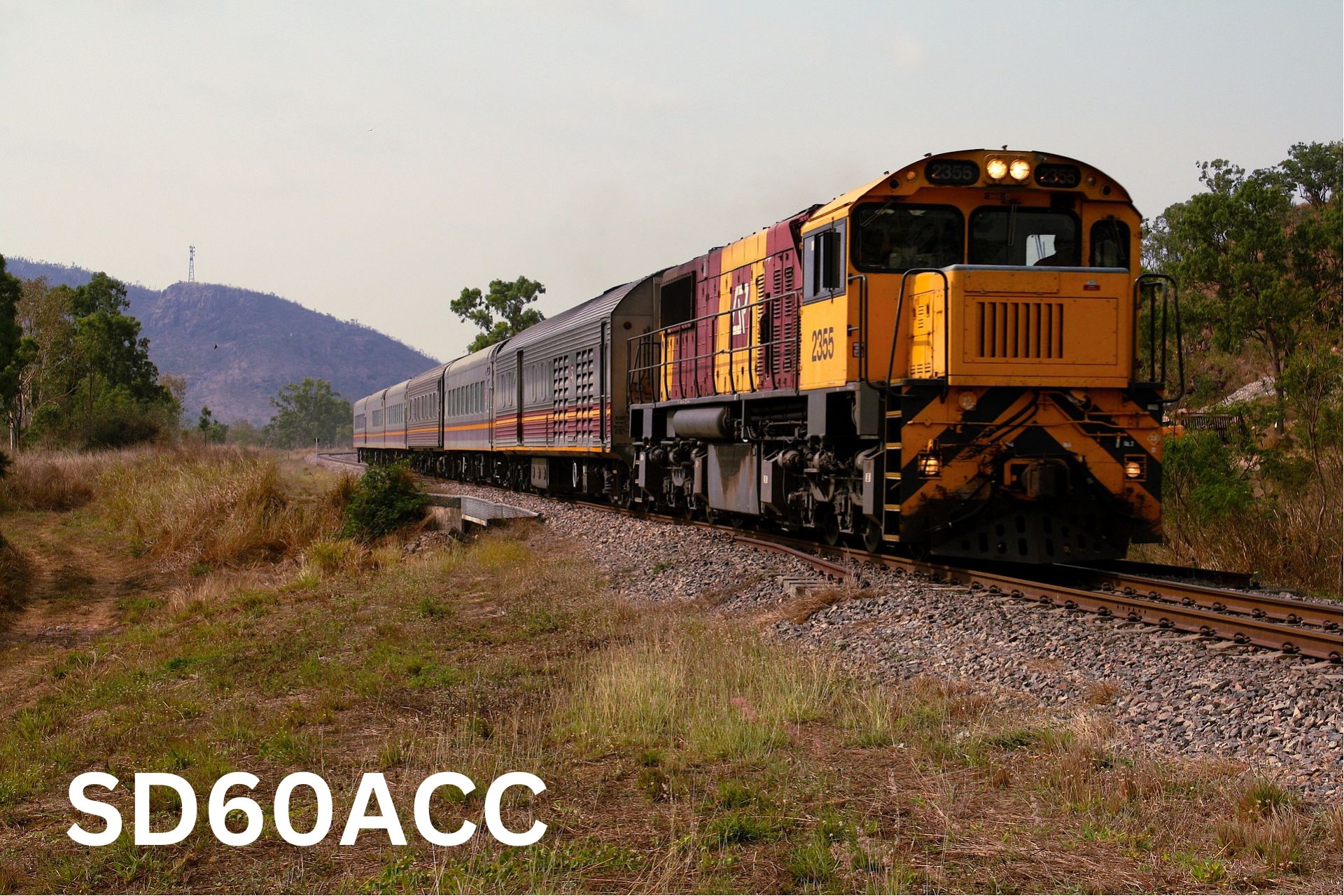The evolution of rail technology is a balance between legacy and innovation. The SD60ACC locomotive perfectly embodies this balance, illustrating how classic machines can be upgraded to meet new standards of power, efficiency, and sustainability. Originally developed in the 1980s as part of the Electro-Motive Diesel (EMD) SD60 series, the SD60ACC has been modernized through a comprehensive conversion process. This transformation has equipped it to serve the demands of modern railways, boasting cutting-edge AC traction systems and other performance improvements. Here, we explore the features, technical specifics, and long-term impact of the SD60ACC on the rail industry.
Contents
- 1 What is the SD60ACC? Understanding Its Design and Legacy
- 2 Why Convert the SD60 to the SD60ACC? Key Motivations for Railroads
- 3 In-Depth Features of the SD60ACC
- 4 Operational Advantages of the SD60ACC: Why Railroads Value It
- 5 The Impact of the SD60ACC on Modern Railroads
- 6 Conclusion: The Legacy and Future of the SD60ACC
- 7 Frequently Asked Questions (FAQs)
What is the SD60ACC? Understanding Its Design and Legacy
The SD60ACC locomotive is a modernized version of the original SD60, known for its rugged design and powerful DC (direct current) traction motors. The “ACC” in SD60ACC stands for “AC Conversion,” highlighting the switch from DC to AC motors, a change that greatly improves performance, reliability, and load capacity. This extensive rebuild, led by Norfolk Southern with the help of Progress Rail, enables the SD60ACC to tackle the challenges of contemporary rail operations, including heavy freight loads and steep inclines, with far greater efficiency and reliability than the original SD60.
Why Convert the SD60 to the SD60ACC? Key Motivations for Railroads
The SD60ACC is a strategic, cost-effective solution for rail operators, allowing them to modernize existing fleets without the steep costs associated with purchasing new locomotives. The AC conversion offers significant operational and financial benefits, making it a popular option for companies aiming to maximize value while meeting contemporary operational standards.
1. Economic Efficiency Over New Purchases
Purchasing brand-new locomotives comes with a hefty price tag. By converting the SD60 to the SD60ACC, railroads can save millions in capital investment. The cost of an AC conversion is significantly lower than buying a new locomotive, and the SD60ACC’s enhanced performance delivers a return on investment that continues well into its extended service life.
2. Enhanced Traction for Heavy Freight Loads
One of the biggest challenges in rail freight is managing traction and load, especially on steep or uneven terrain. The AC traction motors used in the SD60ACC outperform their DC predecessors, providing a greater degree of traction control and stability. This is crucial for maximizing load capacity, which increases productivity for freight operators.
3. Compliance with Environmental Standards
As the rail industry faces growing environmental scrutiny, the SD60ACC conversion is also a move towards sustainability. By upgrading fuel efficiency and reducing emissions, the SD60ACC helps operators adhere to regulatory standards and public expectations for greener transport.
In-Depth Features of the SD60ACC
The SD60ACC isn’t merely a repowered engine; it’s a comprehensive rebuild designed to meet every demand of modern railroading. Here’s a closer look at its core features:
Upgraded AC Traction Motors for Superior Performance
The SD60ACC’s AC traction motors provide a significant upgrade in torque and horsepower. Unlike DC motors, which are limited in their ability to handle continuous heavy loads, AC motors deliver reliable power even in challenging conditions. This technology improves acceleration, smoothens speed transitions, and enhances load stability, making the SD60ACC ideal for long-haul freight.
Advanced Fuel and Emission Controls
To meet stringent emissions regulations, the SD60ACC is equipped with a modernized fuel combustion system that minimizes exhaust emissions. These improvements not only enhance fuel efficiency but also align with environmental mandates, a critical factor for railroads looking to minimize their carbon footprint.
Modern Control and Diagnostic Systems
The SD60ACC’s upgraded electronic control systems allow operators to monitor performance data in real time. Through onboard diagnostics, the locomotive can track fuel consumption, power output, and engine performance, giving maintenance teams actionable insights to prevent issues and reduce downtime.
Crew Comfort and Ergonomic Enhancements
The SD60ACC rebuild also addresses the comfort and safety of its operators. Modernized controls, an improved ergonomic layout, and better climate control systems make for a safer, more comfortable work environment. This attention to crew welfare is especially important for long-distance operators who spend extended hours in the cab.
Operational Advantages of the SD60ACC: Why Railroads Value It
The SD60ACC conversion aligns with several core objectives in the rail industry, from reducing costs to increasing productivity. Let’s examine the operational advantages that make this model invaluable to rail operators:
1. Increased Hauling Capacity for Heavy Freight
The AC traction system allows the SD60ACC to pull heavier loads than traditional DC-powered locomotives. This increase in capacity means rail companies can transport more goods per trip, optimizing fuel use and reducing the number of trips required, both of which have direct cost benefits.
2. Improved Longevity and Reduced Maintenance Costs
The SD60ACC’s durable AC motors, combined with its upgraded diagnostic capabilities, extend the locomotive’s operational life. The streamlined monitoring and maintenance features help rail operators minimize downtime, cut maintenance costs, and ensure reliability for extended operations.
3. Enhanced Performance on Challenging Terrains
The SD60ACC excels in areas with difficult terrain, where traction and load management are critical. Thanks to AC motors’ superior grip, the SD60ACC can maintain stable, efficient performance on slopes and rugged landscapes, providing reliability where it’s needed most.
4. Contribution to Sustainable Transportation
By improving fuel efficiency and reducing emissions, the SD60ACC supports railroads’ environmental initiatives. This green technology reduces the carbon footprint per mile and aligns with modern industry standards for sustainable practices.
The Impact of the SD60ACC on Modern Railroads
The SD60ACC represents a paradigm shift in how railroads approach fleet management and locomotive upgrades. By converting older models, rail companies can bridge the gap between performance and cost-effectiveness. The SD60ACC conversion underscores the industry’s shift towards sustainable operations, with emphasis on longevity, reliability, and eco-friendly practices.
The Future of AC Conversions
With the success of the SD60ACC conversion, other locomotives in the SD series and beyond may undergo similar upgrades, establishing a new industry standard. The continued adoption of AC traction technology in locomotive rebuilds reflects the rail industry’s commitment to evolving its fleets in line with current demands.
Conclusion: The Legacy and Future of the SD60ACC
The SD60ACC conversion exemplifies how the rail industry can adapt to modern challenges without abandoning its legacy. The AC-powered SD60ACC is a testament to engineering innovation, transforming a 1980s classic into a formidable locomotive for the modern era. As railroads continue to seek efficient, sustainable, and powerful solutions, the SD60ACC stands out as a model for balancing tradition with forward-thinking technology.
Frequently Asked Questions (FAQs)
What does SD60ACC mean?
SD60ACC stands for AC Conversion of the SD60 series, indicating the conversion from DC to AC traction motors.
What are the primary benefits of the SD60ACC conversion?
The conversion enhances load capacity, traction, fuel efficiency, and engine longevity, offering a cost-effective and sustainable solution.
How long is the service life of the SD60ACC?
With proper maintenance, the SD60ACC can serve an additional 20-30 years post-conversion.
Who operates the SD60ACC?
Norfolk Southern is a major operator, having collaborated with Progress Rail on the AC conversions.
How does the SD60ACC support environmental goals?
Through improved fuel efficiency and reduced emissions, the SD60ACC helps rail operators meet sustainability standards.











